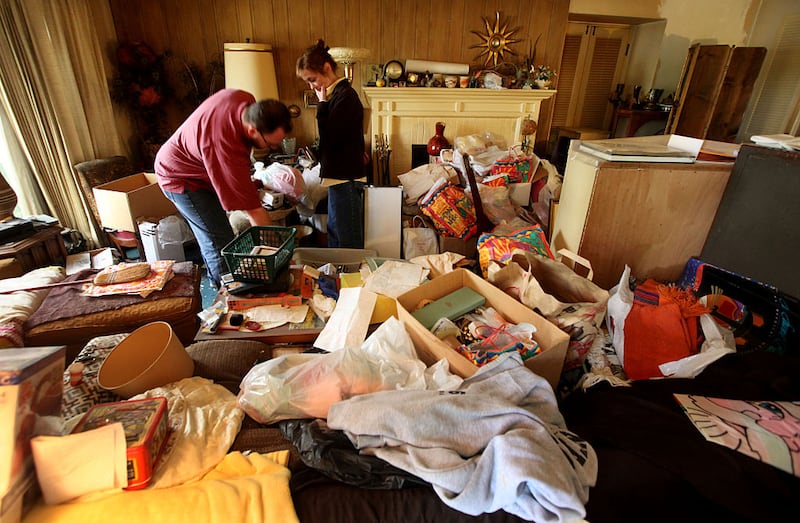It is a story that's hard to believe – an elderly New York woman apparently lived for decades in a room filled with trash, rotting food and the skeletal remains of her son.
In an even more unbelievable twist, investigators say the woman, Rita Wolfensohn, may not have even known she was living with the corpse of her son.
Police described the room the remains were found in as looking like “a garbage truck had dumped its load” inside, with hardly a place to put a foot. Wolfensohn, who is legally blind, was reported to have stayed in the room most of the time.
The skeletal remains of Wolfensohn’s son were found on a mattress on the floor, clad in a shirt, pants and socks. Authorities believe the remains could have been there for as long as 20 years.
While it seems impossible that Wolfensohn would fail to notice the body of her son on a mattress in her room, psychologists say it’s not at all hard to imagine a room where there would be so much debris a body could go unnoticed.
The term “hoarding,” as a mental health issue, has become familiar to many thanks to a cable television series that features people with the disorder who somehow live in homes so crammed with stuff that it’s difficult to walk through them.
According to psychologists, hoarding, in that sense, is a mental health affliction similar to obsessive-compulsive disorder. The person who hoards feels they cannot discard anything and becomes anxious at the thought of getting rid of items.
What causes the disorder and what can be done about it? Here’s a look at hoarding, how it’s diagnosed and how it is treated.
What is hoarding?
Hoarding is a psychological disorder that, according to the American Psychiatric Association is defined by "excessively saving items that others may view as worthless." People with the disorder "have persistent difficulty getting rid of or parting with possessions, leading to clutter that disrupts their ability to use their living or work spaces."
How many people have it?
It’s estimated that 2 to 5 percent of Americans have a hoarding disorder.
Diagnosing it
How do you know if you have a hoarding disorder? A person with hoarding disorder has difficulty throwing items away. They believe, according to the APA, that they need to keep items for use in the future. Symptoms that would lead to a diagnosis of hoarding include:
• Cluttered living spaces
• Inability to discard items
• Keeping stacks of newspapers, magazines, or junk mail
• Moving items from one pile to another without discarding anything
• Acquiring unneeded or seemingly useless items, including trash
• Difficulty managing daily activities, procrastinating and trouble making decisions
• Difficulty organizing items
• Perfectionism
• Excessive attachment to possessions and discomfort letting others touch or borrow possessions
• Limited or no social interactions
What causes hoarding?
According to the AMA:
- Hoarding is more common among individuals with a family member who also has a problem with hoarding.
- Brain injuries have also been found to cause secondary or acquired hoarding symptoms in some.
- Hoarding disorder is also associated with distinct abnormalities of brain function and neuropsychological performance, distinct from those seen in people with OCD or other disorders.
Is there a “typical” hoarder?
According to the Mayo Clinic, hoarders tend to be:
• Around 50 years old, though their tendencies to hoard likely began between the ages of 11 to 15. They may have saved broken toys, outdated school papers, and pencil nubs.
• Indecisive
• Possibly the child of a hoarder, though it is not considered a genetic disorder
• Survivors of a traumatic event; A stressful life event can also trigger or worsen symptoms of hoarding (death of a loved one; job loss).
• Withdrawn or not participating in social activities
What’s the difference between hoarding and being a “packrat?”
According to Prof. Randy O. Frost, author of "Stuff: Compulsive Hoarding and The Meaning Of Things," the difference is in how the collection is stored and organized, not necessarily the amount of stuff. "For the person whose collecting has become hoarding, possessions become unorganized piles of clutter that are so large that they prevent rooms from being used for normal activities," Frost told the Huffington Post.
Can it be treated?
There are two main types of treatment that help people with hoarding disorder, according to the AMA: cognitive-behavioral therapy (CBT) and medication.
“During CBT, individuals gradually learn to discard unnecessary items with less distress, diminishing their exaggerated perceived need or desire to save these possessions”
“For some people, medications are helpful and may help improve symptoms.”
Questions to ask to determine if someone is a hoarder
A professional assessment for hoarding may include questions such as:
• Do you have trouble discarding (or recycling, selling or giving away) things that most other people would get rid of?
• Because of the clutter or number of possessions, how difficult is it to use the rooms and surfaces in your home?
• To what extent do you buy items or acquire free things that you do not need or have enough space for?
• To what extent do your hoarding, saving, acquisition and clutter affect your daily functioning?
• How much do these symptoms interfere with school, work or your social or family life?
• How much distress do these symptoms cause you?
Cox Media Group







